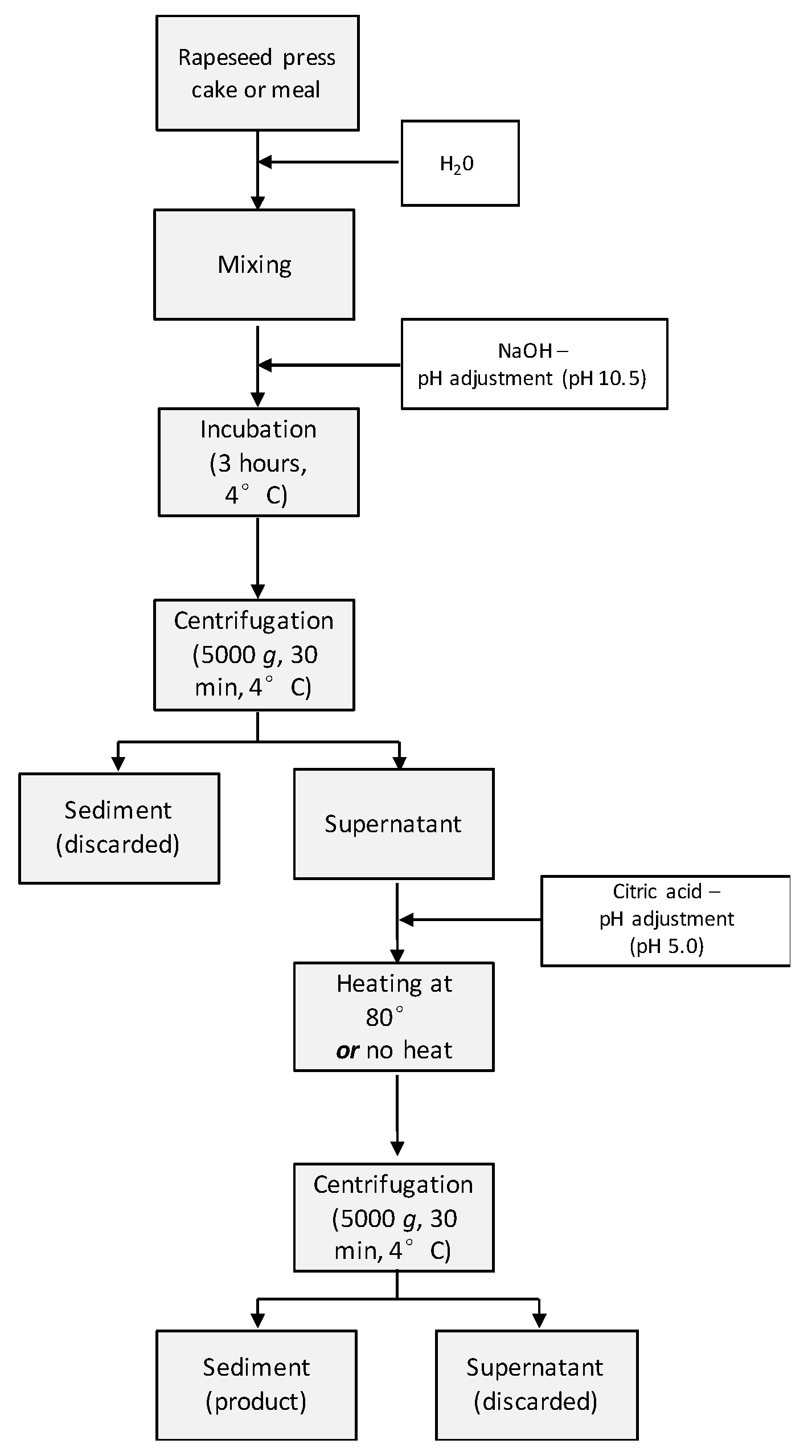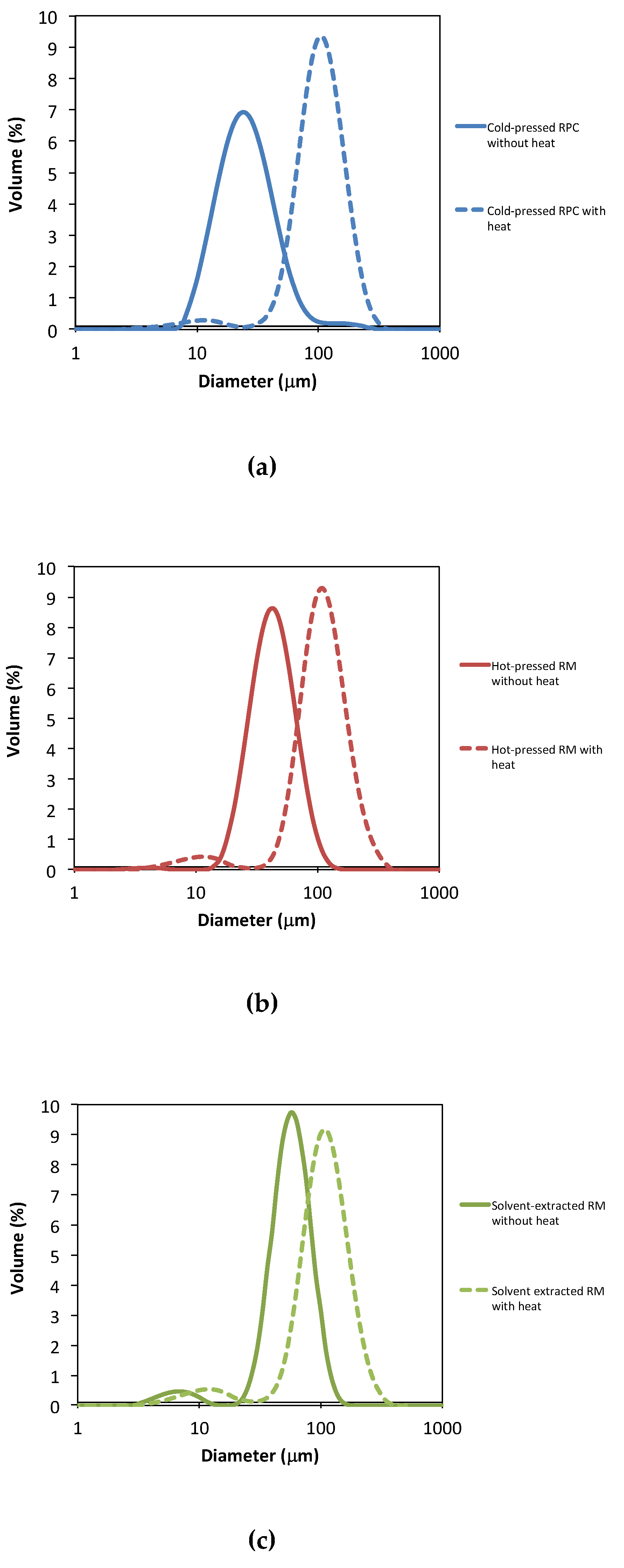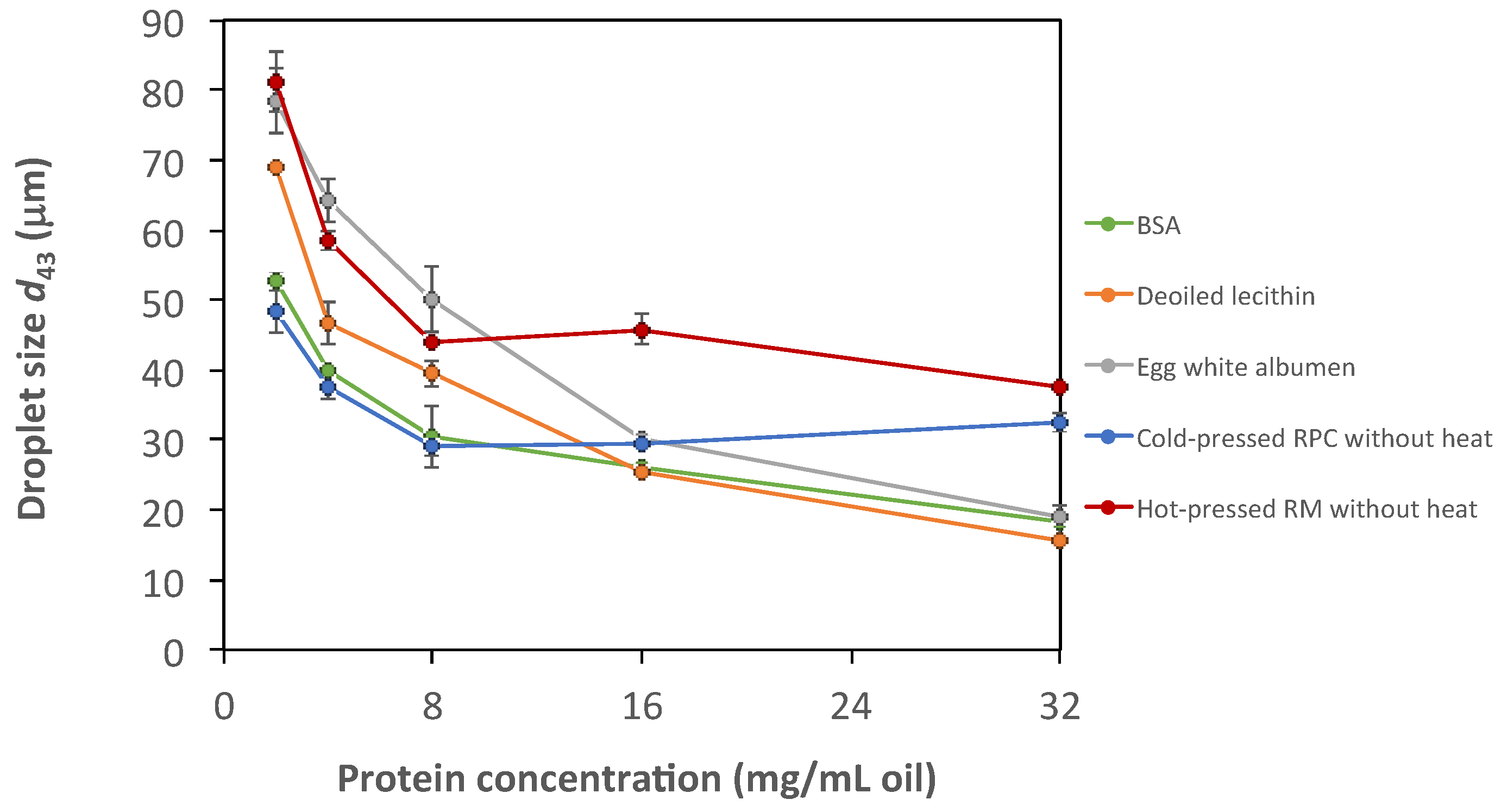The Effects of Oil Extraction Methods on Recovery Yield and Emulsifying Properties of Proteins from Rapeseed Meal and Press Cake
Abstract
1. Introduction
2. Materials and Methods
2.1. Materials and Chemicals
2.2. Protein Extraction from Rapeseed Press Cake
2.3. Proximate Analysis
2.4. Emulsifying Properties of Emulsions Stabilized by Rapeseed Proteins
2.4.1. Preparation of Emulsions
2.4.2. Particle Size Analysis of Emulsions
2.5. Statistical Analysis
3. Results and Discussion
3.1. Effect of Pressing Process on Protein Recovery Yield
3.2. Protein Concentration and Mass of Sediment
3.3. Emulsifying Properties
4. Conclusions
Author Contributions
Funding
Conflicts of Interest
References
- Hallström, E.; Carlsson-Kanyama, A.; Börjesson, P. Environmental impact of dietary change: A systemic review. J. Clean. Prod. 2015, 91, 1–11. [Google Scholar] [CrossRef]
- Macrae, R.; Cuddeford, V.; Young, S.B.; Matsubuchi-Shaw, M. The food system and climate change: An exploration of emerging strategies to reduce GHG emissions in Canada. Agroecol. Sustain. Food 2013, 37, 933–963. [Google Scholar] [CrossRef]
- Shepon, A.; Eshel, G.; Noor, E.; Milo, R. Energy and protein feed-to-food conversion effiencies in the US and potential food security gains from dietary changes. Environ. Res. Lett. 2016, 11, 105002. [Google Scholar] [CrossRef]
- Veeramani, V.; Dias, G.M.; Kirkpatrick, S.I. Carbon footprint of dietary patterns in Ontario, Canada: A case study based on actual food consumption. J. Clean. Prod. 2017, 162, 1398–1406. [Google Scholar] [CrossRef]
- Smil, V. Eating meat: Constants and changes. Glob. Food Secur. 2014, 3, 67–71. [Google Scholar] [CrossRef]
- Aiking, H. Future protein supply. Trends Food Sci. Technol. 2011, 22, 112–120. [Google Scholar] [CrossRef]
- Springmann, M.; Clark, M.; Mason-D’Croz, D.; Wiebe, K.; Bordirsky, B.L.; Lassaletta, L.; de Vries, W.; Vermeulen, S.J.; Herrero, M.; Carlson, K.M.; et al. Options for keeping the food system within environmental limits. Nature 2018, 562, 519–525. [Google Scholar] [CrossRef]
- FAOSTAT. Available online: http://www.fao.org/faostat/en/?#data/QC (accessed on 6 May 2019).
- Ivanova, P.; Kalaydzhiev, H.; Rustad, T.; Silva, C.L.; Chalova, V.I. Comparative biochemical profile of protein-rich products obtained from industrial rapeseed meal. Emir. J. Food Agric. 2017, 29, 170–178. [Google Scholar] [CrossRef]
- CCC, Canola Council of Canada. Available online: http://www.canolacouncil.org (accessed on 25 October 2019).
- Wanasundara, J.P.D.; Tan, S.H.; Alashi, A.M.; Pudel, F.; Blanchard, C. Proteins from Canola/Rapeseed: Current status. In Sustainable Protein Sources, 1st ed.; Nadathur, S., Wanasundara, D.J.P.D., Scanlin, L., Eds.; Academic Press: Cambridge, MA, USA, 2016; pp. 285–304. [Google Scholar]
- Bell, J.M. Factors affecting the nutrional value of canola meal: A review. Can. J. Anim. Sci. 1993, 73, 679–697. [Google Scholar] [CrossRef]
- Rodrigues, I.M.; Carvalho, M.G.V.; Rocha, J.M. Increase of protein extraction yield from rapeseed meal through a pretreatment with phytase. J. Sci. Food Agric. 2017, 97, 2641–2646. [Google Scholar] [CrossRef]
- Tzeng, Y.M. Preparation of rapeseed protein isolates using ultrafiltration, precipitation and diafiltration. Can. Inst. Food Sci. Technol. J. 1988, 21, 419–424. [Google Scholar] [CrossRef]
- Gésan-Guiziou, G. Dairy Industry and Animal Products Processing Applications. In Engineering Aspects of Membrane Separation and Application in Food Processing; CRC Press, Taylor & Francis Group: Boca Raton, FL, USA, 2017. [Google Scholar]
- Von Der Haar, D.; Müller, K.; Bader-Mittermaier, S.; Eisner, P. Rapeseed proteins—Production methods and possible application ranges. OCL 2014, 21, D104. [Google Scholar] [CrossRef]
- Aluko, R.E.; McIntosh, T. Polypeptide profile and functional properties of defatted meals and protein isolates of canola seeds. J. Sci. Food Agric. 2001, 81, 391–396. [Google Scholar] [CrossRef]
- Yoshie-Stark, Y.; Wada, Y.; Wäsche, A. Chemical composition, functional properties, and bioactivities of rapeseed protein isolates. Food Chem. 2008, 107, 32–39. [Google Scholar] [CrossRef]
- Dong, X.Y.; Guo, L.L.; Wei, F.; Li, J.F.; Jiang, M.L.; Li, G.M.; Zhao, Y.D.; Chen, H. Some characteristics and functional properties of rapeseed protein prepared by ultrasonication, ultrafiltration and isoelectric precipitation. J. Sci. Food Agric. 2011, 91, 1488–1498. [Google Scholar] [CrossRef]
- Tan, S.H.; Mailer, R.J.; Blanchard, C.L.; Agboola, S.O. Extraction and characterization of protein fractions from Australian canola meals. Food Res. Int. 2011, 44, 1075–1082. [Google Scholar] [CrossRef]
- Manamperi, W.; Wiesenborn, D.; Chang, S.; Pryor, S. Effects of protein separation conditions on the functional and thermal properties of canola protein isolates. J. Food Sci. 2011, 76, 266–273. [Google Scholar] [CrossRef]
- Gerzhova, A.; Mondor, M.; Benali, M.; Aider, M. A comparative study between the electro-activation technique and conventional extraction method on the extractability, composition and physicochemical properties of canola protein concentrates and isolates. Food Biosci. 2015, 2, 56–71. [Google Scholar] [CrossRef]
- Fetzer, A.; Herfellner, T.; Stäbler, A.; Menner, M.; Eisner, P. Influence of process conditions during aqueous protein extraction upon yield from pre-pressed and cold-pressed press cake. Ind. Crop. Prod. 2018, 112, 236–246. [Google Scholar] [CrossRef]
- Klockeman, D.M.; Toledo, R.; Sims, K.A. Isolation and characterization of defatted canola meal protein. J. Agric. Food Chem. 1997, 45, 3867–3870. [Google Scholar] [CrossRef]
- Ramlan, M.; Maruyama, N.; Adachi, M.; Hontani, N.; Saka, S.; Kato, N.; Ohkawa, Y.; Utsumi, S. Comparison of protein chemical and physicochemical properties of rapeseed cruciferin with those of soybean glycinin. J. Agric. Food Chem. 2002, 50, 7380–7385. [Google Scholar] [CrossRef]
- Wijesundera, C.; Shen, Z. Mimicking natural oil bodies for stabilising oil-in-water food emulsions. Lipid Technol. 2014, 26, 151–153. [Google Scholar] [CrossRef]
- Tan, S.H.; Mailer, R.J.; Blanchard, C.L.; Agboola, S.O. Canola proteins for human consumption: Extraction, profile, and functional properties. J. Food Sci. 2011, 76, R16–R28. [Google Scholar] [CrossRef] [PubMed]
- Huang, A. Oleosins and oil bodies in seeds and other organs. Plant Physiol. 1996, 110, 1055. [Google Scholar] [CrossRef] [PubMed]
- Rayner, M. Current status on novel ways for stabilizing food dispersions by oleosins, particles and microgels. Curr. Opin. Food Sci. 2015, 3, 94–109. [Google Scholar] [CrossRef]
- Campbell, L.; Rempel, C.; Wanasundara, J. Canola/Rapeseed Protein: Future Opportunities and Directions—Workshop Proceedings of IRC; Multidisciplinary Digital Publishing Institute: Basel, Switzerland, 2015. [Google Scholar]
- Wijesundera, C.; Boiteau, T.; Xu, X.; Shen, Z.; Watkins, P.; Logan, A. Stabilization of fish oil-in-water emulsions with oleosin extracted from canola meal. J. Food Sci. 2013, 78, C1340–C1347. [Google Scholar] [CrossRef]
- Wu, J.; Muir, A. Comparative structural, emulsifying, and biological properties of 2 major canola proteins, cruciferin and napin. J. Food Sci. 2008, 73, 210–216. [Google Scholar] [CrossRef]
- Aichinger, P.A.; Schmitt, C.; Gunes, D.Z.; Leser, M.E.; Sagalowicz, L.; Michel, M. Phase separation in food material design inspired by nature: Or: What ice cream can learn from frogs. Curr. Opin. Coll. 2017, 28, 56–62. [Google Scholar] [CrossRef]
- Blaicher, F.M.; Elstner, F.; Sein, W.; Mukherjee, K.D. Rapeseed protein isolates: Effect of processing on yield and composition of protein. J. Agric. Food Chem. 1983, 31, 358–362. [Google Scholar] [CrossRef]
- Aider, M.; Barbana, C. Canola proteins: Composition, extraction, functional properties, bioactivity, applications as a food ingredient and allergenicity—A practical and critical review. Trends Food Sci. Technol. 2011, 22, 21–39. [Google Scholar] [CrossRef]
- Chabanon, G.; Chevalot, I.; Framboisier, X.; Chenu, S.; Marc, I. Hydrolysis of rapeseed protein isolates: Kinetics, characterization and functional properties of hydrolysates. Process. Biochem. 2007, 42, 1419–1428. [Google Scholar] [CrossRef]
- Paulson, A.T.; Tung, M.A. Thermally induced gelation of succinylated canola protein isolate. J. Agric. Food Chem. 1989, 37, 319–326. [Google Scholar] [CrossRef]
- Ferry, J.D. Protein gels. Adv. Protein Chem. 1948, 4, 1–78. [Google Scholar] [PubMed]
- Hermansson, A.M. Physico-chemical aspects of soy proteins structure formation. J. Texture Stud. 1978, 9, 33–58. [Google Scholar] [CrossRef]
- Liu, C.; Lin, X.L.; Wan, Z.; Zou, Y.; Cheng, F.F.; Yang, X.Q. The physicochemical properties, in vitro binding capacities and in vivo hypocholesterolemic activity of soluble dietary fiber extracted from soy hulls. Food Funct. 2016, 7, 4830–4840. [Google Scholar] [CrossRef] [PubMed]
- Leandros, P.; Voutsinas, E.C.; Shuryo, N. Relationships of hydrophobicity to emulsifying properties of heat denatured proteins. J. Food Sci. 1983, 48, 26–32. [Google Scholar]
- Khattab, R.; Arntfield, S.D. Functional properties of raw and processed canola meal. LWT—Food Sci. Technol. 2009, 42, 1119–1124. [Google Scholar] [CrossRef]
- He, R.; He, H.Y.; Chao, D.; Ju, X.; Aluko, R. Effects of high pressure and heat treatments on physicochemical and gelation properties of rapeseed protein isolate. Food Bioprocess Technol. 2014, 7, 1344–1353. [Google Scholar] [CrossRef]
- Flores-Jiménez, N.T.; Ulloa, J.A.; Silvas, J.E.U.; Ramírez, J.C.R.; Ulloa, P.R.; Rosales, P.U.B.; Carrillo, Y.S.; Leyva, R.G. Effect of high-intensity ultrasound on the compositional, physicochemical, biochemical, functional and structural properties of canola (Brassica napus L.) protein isolate. Food Res. Int. 2019, 121, 947–956. [Google Scholar] [CrossRef]





| Pressing Process | Heat in Isolation Process | Wet Mass of Sediment (g) | Moisture Content of Sediment (%) | Protein Concentration of Sediment (%) DM Basis | Oil Content of Sediment (%) DM Basis |
|---|---|---|---|---|---|
| Cold-pressed RPC | No | 30 ± 1 | 68 ± 0.9 | 65 ± 2 | 20 ± 0.4 |
| Hot-pressed RM | No | 14 ± 0.5 | 59 ± 0.9 | 79 ± 3 | 7.9 ± 0.8 |
| Solvent-extracted RM | No | 5.5 ± 0.3 | 80 ± 1 | 72 ± 18 | 2.4 ± 0.3 |
| Cold-pressed RPC | Yes | 43 ± 1 | 82 ± 1 | 44 ± 4 | 19 ± 0.2 |
| Hot-pressed RM | Yes | 31 ± 2 | 80 ± 2 | 61 ± 10 | 9.5 ± 0.4 |
| Solvent-extracted RM | Yes | 11 ± 0.4 | 89 ± 1 | 88 ± 1 | 1.5 ± 0.3 |
© 2019 by the authors. Licensee MDPI, Basel, Switzerland. This article is an open access article distributed under the terms and conditions of the Creative Commons Attribution (CC BY) license (http://creativecommons.org/licenses/by/4.0/).
Share and Cite
Östbring, K.; Malmqvist, E.; Nilsson, K.; Rosenlind, I.; Rayner, M. The Effects of Oil Extraction Methods on Recovery Yield and Emulsifying Properties of Proteins from Rapeseed Meal and Press Cake. Foods 2020, 9, 19. https://doi.org/10.3390/foods9010019
Östbring K, Malmqvist E, Nilsson K, Rosenlind I, Rayner M. The Effects of Oil Extraction Methods on Recovery Yield and Emulsifying Properties of Proteins from Rapeseed Meal and Press Cake. Foods. 2020; 9(1):19. https://doi.org/10.3390/foods9010019
Chicago/Turabian StyleÖstbring, Karolina, Emma Malmqvist, Kajsa Nilsson, Ia Rosenlind, and Marilyn Rayner. 2020. "The Effects of Oil Extraction Methods on Recovery Yield and Emulsifying Properties of Proteins from Rapeseed Meal and Press Cake" Foods 9, no. 1: 19. https://doi.org/10.3390/foods9010019
APA StyleÖstbring, K., Malmqvist, E., Nilsson, K., Rosenlind, I., & Rayner, M. (2020). The Effects of Oil Extraction Methods on Recovery Yield and Emulsifying Properties of Proteins from Rapeseed Meal and Press Cake. Foods, 9(1), 19. https://doi.org/10.3390/foods9010019





